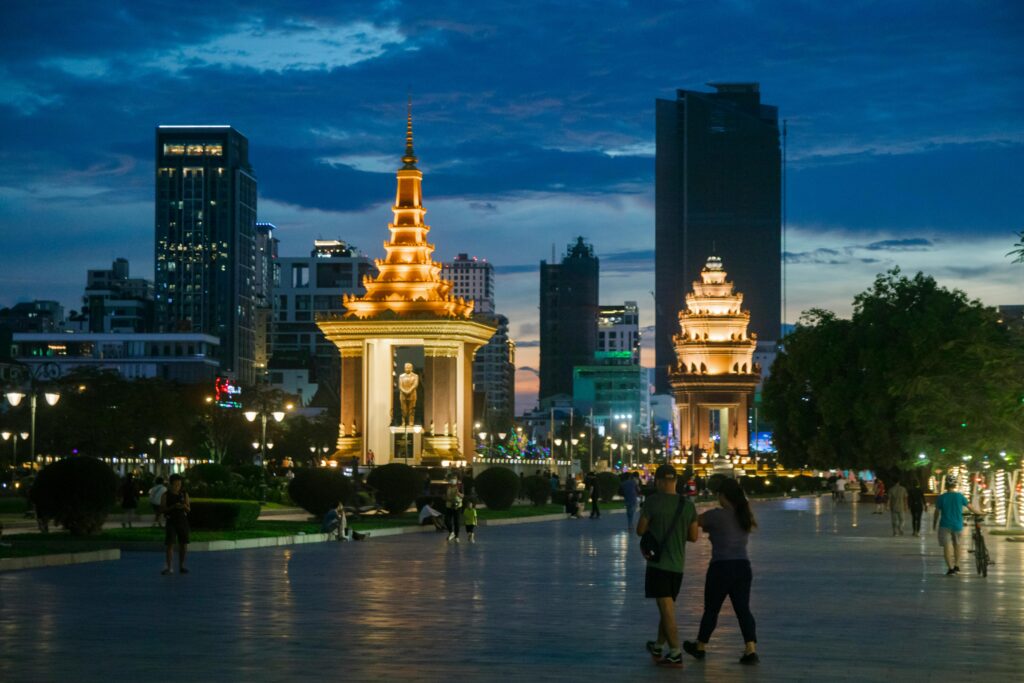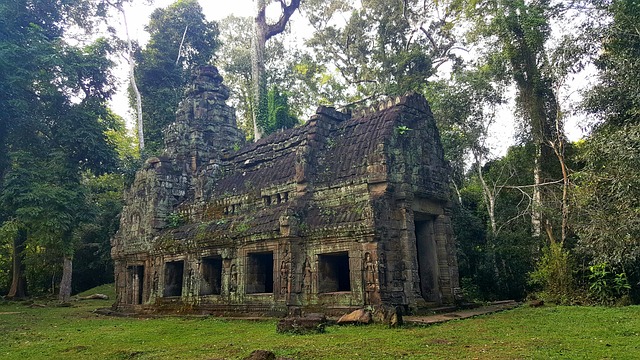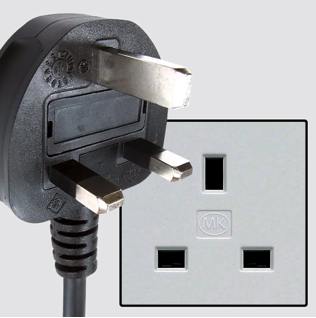Cambodia / ព្រះរាជាណាចក្រកម្ពុជា / Preăh Réachéanachâkr Kâmpŭchéa – Let’s explore here
What’s it like in Cambodia?
Cambodia is a stunningly beautiful forested country in south east Asia. It is composed of a central plain surrounded by the low lying Dângrêk Mountains. The highest point is Phnom Aural, at 5,948 ft (1,813 m) above sea level. In the centre of the country lies a large lake called the Tonle Sap, which can cause floods up to 9,500 square miles (24,605 square km) in size during the rainy season.
It has a very long, rich and troubled history. Its neighbours include Thailand, Laos and Vietnam.
The population of Cambodia is around 17½ million people (2024), about one in five of whom live in the metropolitan area of the capital, Phnom Penh. The country has a young population, with over half being under the age of 22 years.


A bit about the history of Cambodia
Early History and the Khmer Empire
The history of Cambodia dates back to ancient times, with the rise of the Khmer Empire in the 9th century. The empire, which lasted from the 9th to the 15th centuries, was one of south east Asia’s most powerful civilisations. It was centered in Angkor, where the famous Angkor Wat temple was built. The Khmer Empire dominated much of south east Asia, including present day Cambodia, Thailand, Laos and Vietnam. The empire was known for its advanced architecture, irrigation systems and a sophisticated culture.
Decline of the Khmer Empire
By the 15th century, the Khmer Empire began to decline, partly due to internal strife, invasions and shifts in trade routes. The capital, Angkor, was abandoned, and the empire’s power weakened. Cambodia came under the influence of neighbouring kingdoms, particularly Thailand and Vietnam. This period marked the start of Cambodia’s vulnerability to foreign domination.
Colonial Period under France
In the 19th century, Cambodia became a French protectorate in 1863. France aimed to control Cambodia’s resources and integrate it into its colonial empire in Indochina. Under French rule, Cambodia faced significant economic exploitation, though some modernisation was introduced, including infrastructure development and the establishment of a colonial administration. The French also sought to preserve the monarchy as a symbol of continuity, and King Norodom I ruled during much of this period.
World War II and Japanese Occupation
During World War II, Cambodia, as part of French Indochina, was briefly occupied by Japan from 1941 to 1945. After Japan’s defeat, Cambodia regained its status as a French protectorate, but the Japanese occupation had a lasting impact on the region’s politics and independence movements.
Path to Independence
In the aftermath of World War II, Cambodia began to push for independence from French colonial rule. This movement was fueled by rising nationalist sentiments and the broader wave of decolonisation sweeping across Asia. Cambodia achieved full independence from France on November 9, 1953, under the leadership of King Norodom Sihanouk.
The Khmer Rouge and the Cambodian Genocide
The most tragic chapter in Cambodia’s modern history occurred in the 1970s. In 1970, a coup led by General Lon Nol overthrew King Sihanouk, and the country became embroiled in the Cambodian Civil War. The communist Khmer Rouge, led by Pol Pot, gained control of the country in 1975. The Khmer Rouge sought to transform Cambodia into an agrarian communist society by forcibly evacuating cities and forcing millions of people into labour camps. Between 1975 and 1979, an estimated 1.7 million people died from execution, starvation and disease in what became known as the Cambodian Genocide. The regime was eventually overthrown by the Vietnamese invasion in 1979.
The Vietnamese Occupation and the Path to Peace
Following the fall of the Khmer Rouge, Vietnam installed a pro-Vietnamese government in Cambodia. This period was marked by instability and conflict, as the Khmer Rouge continued to resist from the border regions. A prolonged civil war ensued until the signing of the Paris Peace Accords in 1991. The accords laid the groundwork for the restoration of peace and the establishment of a constitutional monarchy in Cambodia.
Modern Cambodia
In 1993, Cambodia held its first democratic elections, and the monarchy was restored with King Norodom Sihamoni, the son of King Norodom Sihanouk, becoming the king. Cambodia has since made significant strides in rebuilding its economy, particularly through tourism, garment manufacturing and agriculture. However, the country continues to face challenges such as political instability, corruption and human rights issues.
Cambodia remains a constitutional monarchy with a parliamentary system. The Cambodian People’s Party has been in power for several decades, and the country’s political landscape is heavily influenced by this long standing leadership. Despite its challenges, Cambodia has experienced steady economic growth and is considered one of the emerging economies in south east Asia.


Cambodia road trip
We haven’t finished our planning for road trip though Cambodia yet. When we do though, we’ll post it here, and in the blog.
Hopefully our journey will improve our knowledge of this intriguing and beautiful country, and enable us to meet some interesting people. We’ll be updating this page at that time – don’t forget to check back 🙂
Map of Cambodia

What’s it like to drive in Cambodia?
They drive on the right hand side of the road in Cambodia. In the main, roads are very poor, with many being unsurfaced dirt tracks. Driving standards are also poor.
Do you require an international driving permit in Cambodia?
We’ve created a dedicated page to driving abroad, which answers this question, and more, which you might find helpful.
Can you use your UK driving license when driving through Cambodia?
We’ve created a dedicated page to driving abroad, which answers this question, and more, which you might find helpful.
Do I need a carnet de passages to drive in Cambodia?
We’ve created a dedicated page to driving abroad, which answers this question, and more, which you might find helpful.
What currency do they use in Cambodia?
In Cambodia they use the Cambodian riel and the US dollar. Cash is widely used. The use of credit / debit cards is not widely accepted. Travellers cheques are not readily accepted. There are ATMs in cities and towns throughout the country.
You should make yourself aware of the amount that your bank charges you for using credit and debit cards abroad. Often credit cards are cheaper for purchasing items directly, and for withdrawing cash from ATMs.
What language do they speak in Cambodia?
They speak Khmer in Cambodia. French and English are also widely spoken.
What time zone is Cambodia in?
Remember, when you’re planning your next trip to take a look at what time zone it’s in.
Do I need a visa to visit Cambodia?
We’ve created a dedicated, more comprehensive page on visas, which you should find helpful. Check it out!
Is wild camping legal in Cambodia?
Yes, wild camping is fine in Cambodia.
What plug / socket type do they use in Cambodia?
In Cambodia they use plug / socket types A, C and G.



Health issues in Cambodia
Is it safe to drink water in Cambodia?
No, it is not safe to drink tap water in Cambodia. Bottled water is readily available throughout the country.
What vaccinations are required for Cambodia?
This NHS website is kept up to date with all relevant information on vaccinations in Cambodia.
Phones in Cambodia
What is the country calling code for Cambodia?
The country calling code for Cambodia is +855
What are the emergency phone numbers in Cambodia?
- The emergency number for police in Cambodia is: 117
- In Cambodia, the emergency number for ambulance is: 119
- The emergency number for fire in Cambodia is: 118
If you’ve got some useful info that you’d like to share, let us know!
And don’t forget to check out all the other pictures!
